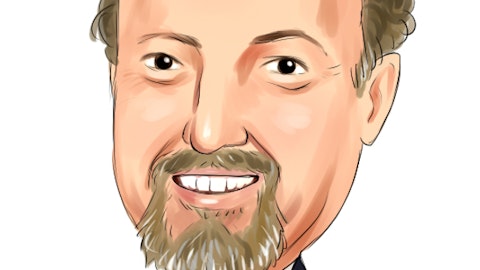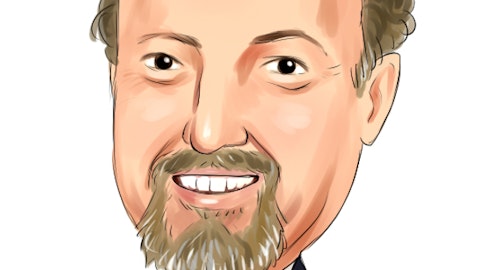Michael Castagna: Yeah. So Oren, without getting really specific, it’s probably going to be for GAAP and non-GAAP. You can see there’s not a tremendous amount of — amounts that go between the two. And we’ve got this foreign exchange gain or loss depending upon the US dollar Euro exchange rate because our purchase commitment for insulin is done in euros. So that can swing in one direction or another over a quarter by $2 million or $3 million or $4 million. So I think just over the next few quarters, we’re going to jump back and forth, we’re going to be spending a little bit more in R&D as you would expect based on what Mike presented on the pipeline. But we’re going to have revenues that are growing at the same time in particular or expect revenues to grow at the same time for Tyvaso DPI royalties in particular, as well as our endocrine business.
And I think some of the timing of the FDA feedback and when those R&D expenses kick in, some of that will be a GAAP issue, some will be a cash flow issue. But in general, we got enough cash to fund those things. But until we get some of that data clarity and the INDs filed and approved, that’s just going to give us a little bit of fluctuation.
Oren Livnat: Got you. Got you. Talking about INHALE, I guess the pump switch study in particular, I think we talked about this last quarter. But can you remind me, you know, what do you think some biggest — assuming the data is compelling and what you hope to see, what do you think the biggest immediate impact from that is? Is it the education and awareness, hopefully dramatically increasing amongst physicians and Type 1 patients as a result? Or is perhaps the bigger lever here, the pharmacoeconomic argument you may be able to make with payers or hopefully would be able to make with payers with regards to relative costs of expensive pumps and whether that might get you a significantly better access over time? And I do have one more follow-up. Thanks.
Michael Castagna: Yeah, I think there’s a couple of things Oren. You hit on a couple of them. The first is lung safety. So getting into kids and showing expected lung outcomes that we would expect and inhale free, some of our latest data on FEV1changes has shown that the control arm is worse than the Afrezza. And so I think really showing new lung data and the reversibility of that is going to be really important. And we feel like we’ve now measured this in a certain way to make it consistent in each trial and timing that reversibility. So that’s going to be an important endpoint combined with having a good pediatric outcome for FDA review and approval. Those couple of things will give us a huge halo effect after — you know, next year will be ten years since FDA approval of Afrezza, and that will give us, hopefully, the length of time on the market, the lack of any safety and surveillance plus these new trial readouts I think are all going to be really critical.
Then there’s two other things I would add or three other things. Number one is education. We have now really world-renowned thought leaders and academic centers running these trials who can now be on podiums, who can now be on publications, who can now do CME that we just didn’t have before. And I think that’s going to be critical in conjunction with marketing and sales training. We’re really putting a lot of investment in our sales force right now on training, skill sets, clinical knowledge, and really teaching them how a patient lives with Type 1, understanding the insulin pumps and what that’s going to mean to a patient and how they position Afrezza in that market. And then as we think about Europe, I do think the INHALE-3 trial will be really important to think about the pharmacoeconomic because in Europe, they do care about the total cost of care being hypoglycemia, medical, as well as pharmacy.
And I do think if we can show, you know, pretty good outcomes with a pump or without a pump, it doesn’t have to be better. It just has to be as good as. There’s a significant cost to consumers as well as society for these insulin pumps and pods. And that’s going to be something important. As we look at Germany, Italy, UK, they’re paying more and more for diabetes technology. And we think now is the time to bring new innovation to Europe as well. But having this data set and the pediatric data set will be important for the global market, not just the US market, but it will help us in the US. I can tell you I just talked to some of the payers this past week and we expect continued Medicare coverage. In fact, we got Medicare to update their website last week around inhaled insulin being covered for 2024 because of the IRA impact.
We know that the price of insulin is coming down. We don’t expect any negative formula positions against us. And I think as we go into 2025, we’ll look at how to use V-Go and Afrezza to open up access together. ’24 is going to be a transition year for everybody given the IRA impact on society and drug companies and discounts and PBMs, a lot of confusion happening for ’24 getting ready for ’25. So that dust will settle. But we expect Afrezza to continue to have a good formulary coverage as well as V-Go as we go forward.
Oren Livnat: Okay. You anticipated my next question, just regarding IRA, it sounds like for the endocrine business, you know, it’s a little bit uncertain, pushes and pulls there. But for Tyvaso DPI, I know that’s UT has launched, but is your understanding that that is only a tailwind as far as to whatever extent it has any impact in 2024?
Michael Castagna: I don’t — I mean, I think I’ll let UT comment, obviously for their future Tyvaso. But what I would say is the Medicare Part D, which is — you know, Tyvaso was a Part B for nebulizer, and the Part D is what the inhaled version is covered for DPI. And so those patients right now have a huge out-of-pocket cost, which does prevent some of them from switching over. And so as you think about Tyvaso going in the next year and the following year, that out-of-pocket cost should be capped at roughly around 3,000 next year and 2,000 the following year, if I recall. And hopefully, that will help continue to provide incremental demand beyond our current trends for Tyvaso DPI. And so that’s something we anticipate as we go forward. That should be a net benefit to patients as you cap those costs as well.
Oren Livnat: All right. Thanks. Appreciate it.
Michael Castagna: Thank you.
Operator: Thank you. [Operator Instructions] One moment for our next question. And our next question comes from Andreas Argyrides of Wedbush Securities.
Andreas Argyrides: Thanks for taking — Yeah, good afternoon. Thanks for taking our questions here. Congrats on all the progress. Just two questions from us. The company’s transformation to an orphan lung story is certainly exciting. Can you provide us with the next steps for submitting INDs for 101 and NTM and 201 and IPF, and then also how you guys are thinking about the Phase 2/3 trial design, endpoints, treatment duration, et cetera? Thank you.
Michael Castagna: I want to make sure I heard your questions, a little fuzzy on my side. INDs and Phase 2/3 design. So on the INDs, we are the number one long haul [indiscernible] the manufacturing stability. So everything else is pretty much on track to be ready in terms of study reports or filing for the IND. And I remember, we were trying to get that filed for Q4, so we were pretty well on our way for that. And so at this point, it’s really, can we bridge some of the clinical supplies from Germany to the US for the dating and for the inventory for the clinical trial? So that’s for 101 and that’s on track for an early Q1, mid-Q1. I’ll say filing, but if we can find a way to get there faster, based on our FDA meeting we have coming up, that’s — we will do that.


